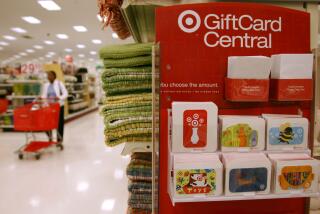Holiday Cards Put Extra Emphasis on Peace
- Share via
PITTSBURGH — With thousands of soldiers encamped in the deserts of the Middle East, peace on Earth may be too much to wish for this holiday season, but there’s good reason to expect peace in your mailbox.
Greeting card industry officials and analysts say holiday cards bearing peace wishes will sell briskly this holiday season, reflecting consumer concerns about the state of the world and events in the Persian Gulf in particular.
And although the sputtering economy is expected to bring a not-so-merry Christmas for the nation’s big retailers, sales of greeting cards should buck that trend, industry analysts said.
“When times are tough, people cut back on buying expensive gifts and buy more expensive cards,” said analyst Kendrick Noble at Paine Webber Inc. in New York.
The Greeting Card Assn., an industry group based in Washington, estimates that 2.3 billion cards will be purchased this holiday season, up from 2.2 billion in 1989.
But for the full year, consumers will spend $4.6 billion on 7.3 billion greeting cards, up nearly 10% from $4.2 billion last year, the association projects.
“It’s going to be a pretty tough Christmas,” said Kevin Moore at Ohio Co. “But on the other hand, greeting cards are a lower-priced kind of purchase and generally more of an impulse purchase.”
Nancy Riviere, a spokeswoman for the trade group, said card sales overall have grown steadily for years. They totaled $2.1 billion in 1980, she noted.
Christmas is by far the leading card-sending holiday, said Riviere. Valentine’s Day and Easter are second and third, respectively, followed by Mother’s Day.
In addition to peace theme cards, the environment is another theme likely to dominate this season and throughout the 1990s, the experts said.
“There is a consumer preference for peace-themed items, such as doves, a reflection of people’s concern over the world situation,” said Steve Doyle of Hallmark Cards Inc. in Kansas City, Mo., the nation’s largest greeting card producer.
Riviere said many manufacturers are jumping on the environmental bandwagon by planning cards made of recycled paper or linking their products to environmentally friendly organizations.
“Retailers are being pushed by consumers to have a green ideology in all their products,” said Jody Roberts, marketing coordinator at Cleveland-based American Greetings Inc., the No. 2 manufacturer.
Roberts said American Greetings plans a complete environmental line of boxed cards for Christmas, 1991, and will introduce a line linked to the National Wildlife Federation before Father’s Day next June.
Other growing categories in the industry are cards that reflect changing social realities--”Merry Christmas, Stepfather” is one example--and cards, particularly those with humorous messages, designed to appeal to younger buyers.
The average family sends a total of 44 Christmas cards, according to the group, 37 of them from boxed sets and seven that are purchased individually.
Nearly 1,000 companies make greeting cards in the United States. But the three largest generate 80% of the sales, the association estimates. Gibson Greetings Inc., based in Cincinnati, is third behind Hallmark and American Greetings.
More to Read
Inside the business of entertainment
The Wide Shot brings you news, analysis and insights on everything from streaming wars to production — and what it all means for the future.
You may occasionally receive promotional content from the Los Angeles Times.










